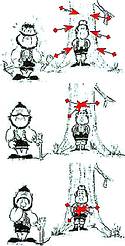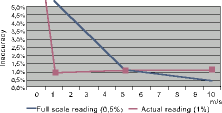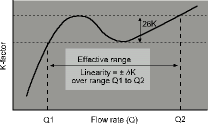
For the reasons mentioned on the previous page, accuracy specifications of different flowmeter technologies or even of ultrasonic flowmeters by different makes cannot always be compared at first sight. In addition, suppliers use different combinations of specifications such as accuracy and repeatability or solely linearity. Please bear in mind that errors are inherent to all measurements and are unavoidable even under ideal conditions. This MPM report is aimed at providing a better understanding of the different flowmeter accuracy specifications and the terminology used.
Accuracy definition
"The closeness of the agreement between the result of the measurement and the true value of the quantity." (ISO 4006)
Accuracy versus repeatability
To understand the difference between accuracy and repeatability, imagine an archer targeting for the bull's eye - representing perfect accuracy - at a conventional archery target - (Figure 1).

1. Suppose the first archer fired his shots all around the bulls-eye, with a good percentage outside the target. The shooting is random and a case of poor accuracy and poor repeatability. It could be, however, that the shots are spread all around the bull's eye but have a correct average value. The archer is however neither accurate nor repeatable. It shows also that repeatability is directly related to the variability of the measure.
2. The second archer hits the bull's eye consistently. As he was always accurate, his shots were repeatable.
3. Imagine the third archer hits the target but misses the bull's eye consistently (the arrows go to the same place, but not at the right place). Although the archer was not accurate he has good repeatability.
Conclusions
* Poor repeatability means poor accuracy.
* Good accuracy automatically implies good measurement repeatability.
* Good repeatability quoted on its own does not guarantee good accuracy.
Accuracy definition
"The closeness of the agreement between the result of the measurement and the true value of the quantity." (ISO 4006)
Accuracy is the ability of a measuring instrument to indicate values closely approximating the true value of the quantity measured. We often speak of a flowmeter having an accuracy of 1%. This would actually mean the meter is 99% inaccurate, so we actually should speak of a flowmeter with an inaccuracy of 1%.
Periodic re-calibrations have always been essential for maintaining high accuracy over time. In the case of turbine and PD meters, after a number of operating hours the k-factor changes, thereby affecting the meter accuracy. Shifting k-factors are caused by changes in process conditions (flow rate, viscosity) and flowmeter conditions (wear of blades bearings, build-up at blades, etc). Inline ultrasonic flowmeters remain accurate over time, because the meter k-factor remains constant. They have no mechanical moving parts and a fixed path length between two sensors. The k-factor is the number of pulses collected during a proving run divided by the indicated volume at run temperature and pressure of the meter.
It may be noted that different suppliers, however, give different accuracy statements. Accuracy for example can be expressed as a percentage of reading or as a percentage of full scale. Some suppliers specify accuracy under reference conditions, other under on-site conditions.
Accuracy: Under reference (or laboratory) and on-site conditions
Accuracy under reference conditions is obtained by calibrating an instrument under laboratory conditions. A range of temperatures, pressures, and flow conditions is specified over which the user could expect the device to perform within a specified reference - accuracy - range. Sometimes accuracy statements are based on on-site calibration results, meaning the values are valid in case the sensors are neither removed nor replaced after the calibration has been done in the field. In these particular cases only the repeatability and reproducibility should be taken into consideration. Please bear in mind that the performance based on on-site calibrations is valid only for one product, for one flow rate or one Reynolds number and cannot be applied to other locations and different process conditions!
Accuracy: Full scale and actual reading
Some suppliers of flowmeters quote accuracy as a percentage of full-scale reading, while others quote it as a percentage of actual reading. The difference between the two concepts becomes highly significant when an instrument is operating near the bottom of its turndown range. This is best explained with an example.

Example 1
Inaccuracy is 0,5% at full scale. The operating range is 1 to 10 m/s.
* At 100% of the flow rate i.e. at full scale (10 m/s), the inaccuracy is 0,5% of full scale or in other words 0,05 m/s over 10 m/s (0,5%).
* At 50% of the flow rate (or 5 m/s), the inaccuracy is still 0,5% of full scale or 0,05 m/s over 5 m/s (1%).
* At 10% of flow rate (or 1 m/s), the inaccuracy is still 0,5% of full scale or 0,05 m/s over 1 m/s (5%).
Actual accuracy diminishes as the operating conditions fall below the full-scale setting. As the flow rate decreases, the errors expressed as a % of the actual value become large.
Example 2
Inaccuracy is 1% of actual reading. The operating range is 1 to 10 m/s.
* At 100% of the flow rate ie at full scale (10 m/s), the inaccuracy is 1% or 1 m/s over 10 m/s.
* At 50% of the flow rate (or 5 m/s), the inaccuracy is 1% of or 0,5 m/s over 5 m/s.
* At 10% of flow rate (or 1 m/s), the inaccuracy is still 1% or 0,01 m/s over 1 m/s.
When is accuracy critical?
Accuracy is needed when a customer is buying, selling (custody transfer) or paying duty (fiscal metering) against meter readings, and for example for truck loading stations.
Repeatability
Repeatability is a measure of the output stability under a given set of flow conditions. It reflects the ability of a flowmeter to repeat output readings under fixed conditions or in other words to measure the same quantity several times in succession. See the following definitions of ISO, OIML and API:
* "The quantity that characterises the ability of an instrument to give identical indications or responses for repeated applications of the same value being measured under the same conditions of use." (ISO 4006)
(a) Metering - The closeness of the agreement between the results of successive measurement of the same quantity carried out by the same method, by the same person, with the same measuring instrument at the same location, over a short period of time. More specifically, the ability of a meter and prover system to repeat its registered volume during a series of consecutive runs under constant operating conditions.
(b) Laboratory test method - the difference between successive test results obtained by the same operator, with the same apparatus, under certain operating conditions, on identical test material using the same test method." (API - Chapter 1, Vocabulary)
* "The difference between the largest and the smallest results of successive measurements of the same quantity carried out under the same conditions." (OIML R-117)
When is repeatability critical?
Good repeatability has a price and depends upon good design and manufacture of an instrument.
A highly accurate, well-calibrated flowmeter could be cost-inefficient if of all one needs is good repeatability eg when an instrument is used solely for controlling purposes or blending.
Reproducibility
(a) Metering - The ability of a meter and prover system to reproduce results over a long period of time in service where the range of variation of pressure, temperature, flow rate, and physical properties of the metered liquid is negligibly small.
(b) Laboratory test method - the difference between two single and independent results obtained by different operators, working in different laboratories, on identical test material using the same test method. (API - Chapter 1 Vocabulary)
Uncertainty
"A range of values within which the true value lies with a stated probability." (ISO 4006)

Whereas accuracy is more a qualitative term, which is used as a kind of collection for all kinds of errors, uncertainty is a quantitative parameter, which is calculated according to statistical, internationally standardised methods. The uncertainty is a measure for the dispersion or variation of the measured values whereby all sources of error, such as calibration errors, flowmeter errors, errors due to relevant influence quantities, are taken into account.
For NKO uncertainty is by definition calculated as two times the standard deviation, corresponding with a confidence level of 95%, ie 95% of the measured values lie within a specified uncertainty around a specified mean value. The stated uncertainty is always the half-width of the interval around the mean value. If, for example, the mean value is 3 and the uncertainty is 0,5, the variation is, with 95% probability, between 2,5 and 3,5.
Rangeability/turndown ratio
The effective range of an instrument is the range over which an instrument meets the specified accuracy requirements. Rangeability is the capability of a flow-measuring device to operate between the minimum and maximum flow range within an acceptable tolerance. Rangeability or turndown ratio is generally expressed as a ratio of the maximum flow to the minimum flow (Q2 / Q1) - (Figure 4).

Linearity
"The deviation within pre-set limits of an instrument's performance from the ideal straight-line relationship between instrument output and the parameter being measured." (ISO 4006)
The ideal accuracy curve of a volume meter is a straight line denoting a constant meter factor (or k-factor). The linearity of an instrument is a measure of the extent to which the calibration curve of an instrument deviates from the best fitting straight line over the effective range - ie between the maximum and minimum flow rates. Linearity is the maximum percentage deviation from the k-factor and is stated as a percentage of the reading or sometimes as a percentage of full scale - (also Figure 4).
Gordon Duff, Krohne
011 315 2685

© Technews Publishing (Pty) Ltd | All Rights Reserved